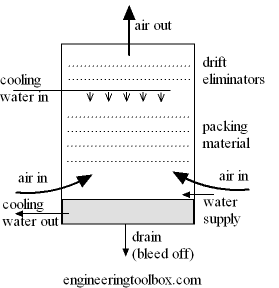Cooling Tower Efficiency
Maximum cooling tower efficiency is limited by the cooling air wet-bulb temperature.
A cooling tower use evaporative cooling to reduce the temperature of circulated water, and
- they can achieve water temperatures below the dry bulb temperature - tdb - of the cooling air
- they are in general smaller and cheaper for the same cooling loads than other cooling systems

Cooling towers are rated in terms of approach and range, where
- the approach is the difference in temperature between the cooled water temperature and the entering air wet bulb temperature - twb - temperature
- the range is the temperature difference between the water inlet and water exit
Note! - for a cooling tower based on evaporative cooling the maximum cooling tower efficiency is limited by the wet bulb temperature of the cooling air.
Cooling Tower Efficiency
Cooling tower efficiency can be expressed as
μ = (ti - to) 100 / (ti -twb) (1)
where
μ = cooling tower efficiency (%) - the common range is between 70 - 75%
ti = inlet temperature of water to the tower (oC, oF)
to = outlet temperature of water from the tower (oC, oF)
twb = wet bulb temperature of air (oC, oF)
The temperature difference between inlet and outlet water (ti - to) is normally in the range 10 - 15 oF.
The water consumption - or the amount of make up water - of a cooling tower is about 0.2-0.3 liter per minute and ton of refrigeration. Compared with the use and waste of city water the water consumption can be reduced with about 90 - 95%.
There are two main types of cooling towers
- forced draught (using fans)
- natural draught
Both types are based on evaporative cooling.
- Natural draught cooling towers are more dependent on temperature gradients between air and water and the wind forces than forced draught cooling towers
- The efficiency of natural draught towers are more variable over time and in general lower
Note! - be aware that a medium temperature system - like cooling a tower - are a known source of pathogenic bacteria causing the Legionnaires disease. Good cleaning and maintenance of the systems are important to minimize the risk.
Related Topics
-
Air Psychrometrics
Moist and humid air calculations. Psychrometric charts and Mollier diagrams. Air-condition systems temperatures, absolute and relative humidities and moisture content in air.
Related Documents
-
Air - Moisture Holding Capacity vs. Temperature
The moisture holding capacity of air increases with temperature. -
Calculating Cooling Loads
Calculating chiller and cooling tower refrigeration loads - in tons. -
Cooling Load - Convert between kW/ton to COP or EER
Convert between cooling load units like kW/ton, COP and EER. -
Cooling Power vs. Airflow and Duct Sizes
Typical relations between cooling power (tons cooling), air flow and duct size -
Cooling Water - Pipe Lines
Sizing cooling water pipe lines - maximum allowable flow, velocity and pressure drops. -
Dry Bulb, Wet Bulb and Dew Point Temperatures
Dry Bulb, Wet Bulb and Dew Point temperatures can be used to determine the state of humid air. -
Efficiency
The measure of usefulness. -
Evaporation from a Water Surface
Evaporation of water from a water surface - like a swimming pool or an open tank - depends on water temperature, air temperature, air humidity and air velocity above the water surface - online calculator. -
Evaporative Cooling
Evaporative cooling tutorial. -
Heat Recovery Efficiency
Classification of heat recovery efficiencies - temperature efficiency, moisture efficiency and enthalpy efficiency - online heat exchanger efficiency calculator. -
Humidifiers
Sprayed coils, spinning discs and steam humidifiers. -
HVAC Terms
Common HVAC industry terms like absolute humidity, pressure, temperature and more. -
Legionella
The Legionella Pneumophila bacterium thrives in water supply systems and air conditioning systems - and may cause the Legionnairs disease. -
Moist Air - Cooling and Dehumidifying
Cooling and dehumidifying processes of moist and humid air - sensible and latent cooling. -
Moist Air - Enthalpy
Sensible and latent heat of moist air.




